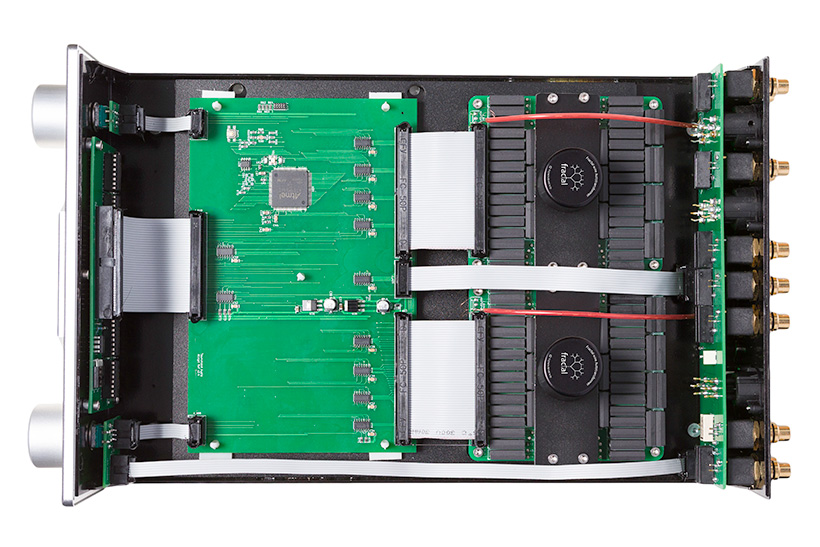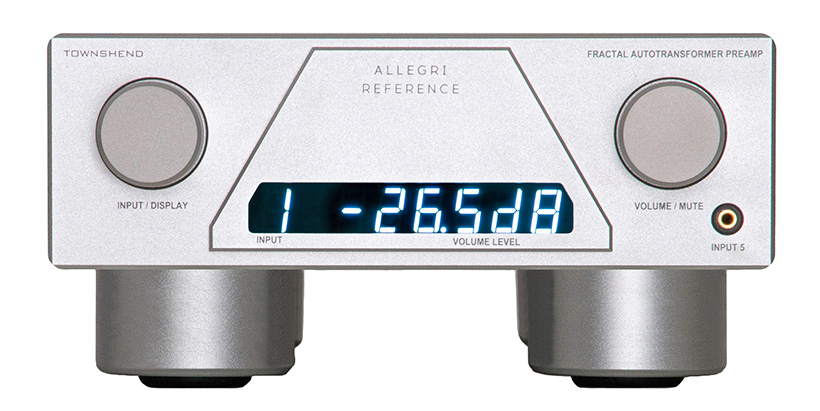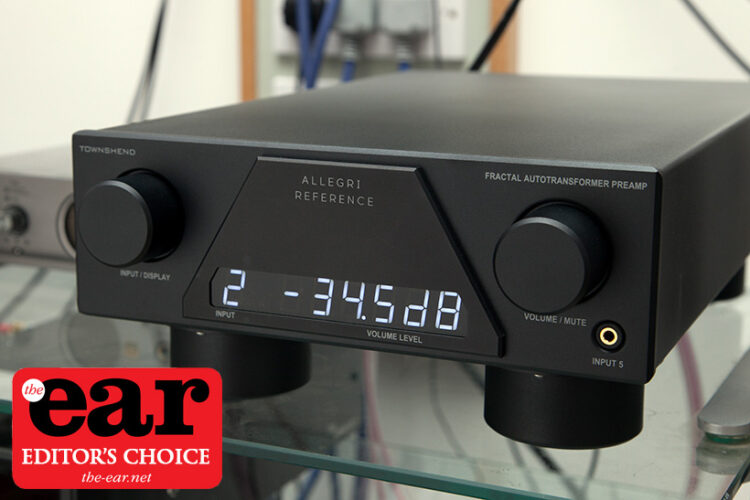You wouldn’t think that attenuating or reducing a signal would be all that difficult, yet this is essentially what preamplifiers do most of the time. Active ones complicate matters by adding gain, which in essence is increasing the signal, but with modern sources there is rarely any need to actually increase it by much unless circumstances further down the audio chain are unusual: combined low gain amplifiers with low sensitivity speakers being the main one. But all preamplifiers struggle to control a signal without both adding distortion and losing some of the smallest/quietest elements of that signal. Passive preamps have an advantage inasmuch as they don’t use electrical power and thus don’t have to go to great lengths to eliminate the noise that comes with it, but their job is not easy nonetheless.
Max Townshend is the real deal, a transmission line engineer by training he started out in hi-fi back in the 70s selling cartridges, then he met Professor Jack Dinsdale of Cranfield Colege who had asked his students to design “the best turntable in the world”. The result was the Cranfield Rock with its distinctive silicone trough to damp vibrations in the cartridge which Max licensed and built as the Elite Rock. Over 40 years later Townshend is still making products that damp vibration notably in the form of bases for speakers and equipment that genuinely isolate down to very low frequencies and which have a profound effect on the performance of that equipment. His latest product has this so-called Seismic isolation built into it in order to allow it to perform at its very best regardless of what it sits on.

The Allegri Reference is Townshend’s latest and most successful passive preamplifier, it builds on the original Allegri autotransformer based line stage (and the Allegri+ currently in production) as well as two earlier projects that attempted to bring greater ease of use and a broader range of volume steps to that design. The Allegri+ is a remarkably transparent line stage preamplifier with single ended in- and outputs and a 24 position stepped attenuator volume control (the nature of transformer volume controls (TVC) means that a conventional sweep attenuator which can be left in any position is not an option). The goal with the Allegri Reference was to provide a wider range of finer volume steps and to offer remote control. Townshend’s first two attempts at this, the Glastonbury Pre-1 and short lived Enigma, used multiple switches to provide extra volume steps but were ultimately undermined by their own complexity, so another approach was needed. Reed relays are electrically operated switches that contained in a vacuum in order to avoid corrosion and thus wear, they are found in many high end amplifiers and can be detected by a distinctive clicking sound. By using 120 Reed relays the Allegri Reference offers 129 half decibel volume steps, to my knowledge it is the only TVC to incorporate this type of switch because combining them with transformers is a complicated business, but they offer lifetime longevity and brings sonic benefits too.
The Allegri Reference has earned itself the nickname Big Foot for obvious reasons, the feet contain damped springs that have been selected to provide isolation from vibration down to 3Hz. They are also adjustable to accommodate heavier than average cabling. The preamp doesn’t bounce, it feels firm, but it sinks a little when you put it down and if you push it the outside of the foot touches the rack. It’s interesting to bypass the isolation by putting book or similar under the preamp, when you do this the image contracts and makes the music more congested, take the book away and it opens up giving the instruments and voices more space and air to do their stuff. In fact this aspect alone looks like a relatively inexpensive upgrade for any preamp, the only critical factor is that the strength of the springs need to match weight of the component; Townshend’s Seismic bases come in a range of spring ratings for this reason. You need a reasonable amount of weight however and the Reference has added mass in the form of a damped constrained layer of heavy gauge steel within it.

The display indicates that this is not an entirely passive device, it needs power to run the display and operate the relays, and this is provided by a linear 12v wall-wart supply that can be left on at all times. The display can be set to be on or off or to stay on for five seconds or five minutes after a change of input or volume. You can also reduce the level of any input in order to match it to the lowest of the connected sources, in my case that meant dropping the DAC input to bring it closer to the relatively low level of my phono stage. There is even the option to set an input to unity gain to bypass the preamp in an AV system. An Apple remote handset is provided with the Reference that allows access to all the functions mentioned above, it’s a very nice piece of machined aluminium and seems to work regardless of where it’s pointed. The only drawback is its slim profile which means it can get into the gaps in the sofa with consummate ease.
In- and output wise this preamp isn’t quite as well equipped as it would appear, there are five inputs but seven pairs of sockets on the back panel of which two are XLRs, there is also a 3.5mm minijack input on the front. The XLRs share the same input as two RCAs and the minijack shares input 5 with another set of RCAs. You can have all eight connected simultaneously but playing signal through two that share the same input is unlikely to sound great.

Sound quality
What first hits you when using the Allegri Reference is that there is no grain, no edginess, no glare. It’s almost miraculous that sources and recordings which seemed hard and forward are suddenly listenable and easy to enjoy. Yet it doesn’t smooth over the mid and treble to achieve this, there are mountains of detail and it’s presented in a totally coherent and precisely defined fashion. This is something I have encountered with a few high end preamplifiers in the past, but they were £25k plus active devices of the substantial variety. Nor did they manage to combine this smoothness of presentation with the speed and clarity on offer here, a really serious tube preamplifier might get close but such designs usually fall short when it comes to noise. They inevitably have a noise floor that while not obvious conceals the quieter details, the Reference has essentially no noise because it doesn’t amplify the signal, it merely reduces its strength in the least obtrusive way possible.
This does fabulous things for your music, opening up every recording so that you can hear precisely what went on in the studio and transporting you to that spot behind the mixing desk (recording quality allowing). But it’s not just good for great recordings, it’s great for all of the music you love because more is more when it comes musical enjoyment. Esperanza Spalding’s ‘Ebony and Ivory’ features high speed spoken word at the start and a voice over many others voices at the end, in both cases it is difficult to understand exactly what’s being said, although the message is very clear. The Allegri Reference lets you hear into the mix and distinguish the words alongside the fabulous texture of sound she gets on the bass guitar. The Grateful Dead’s ‘Cumberland Blues’ can sound a bit forward and grainy, it’s a 1972 live recording of the band at its peak but the sound is not sweet, with this preamp you get all the energy and dynamism of the performance without the edginess that usually comes with it. Preamps are a bit like sand paper, they come in over a thousand grades, it’s only when you get up to the finest grades do they stop adding leading edge grit of their own and let you hear what is on the record.

It’s interesting to contrast this Townshend with an active preamplifier like the ATC CA2, the latter thickens up the bass which makes some recordings sound more appealing but it doesn’t deliver anything like the transparency to musical detail that the Allegri Reference does. Nor does it do the trick with the grain in leading edges, and this is true of an awful lot of amplifiers. Even MP3 can sound good through the Allegri Reference as I discovered with a promo of Floating Points’ ‘Bias’, a proper bangin’ choon track that sounds hard edged under normal circumstances. It lets you hear more in a musically compelling fashion too, especially with a great source like the Rega P10/Aphelion 2 record player and Tom Evans Groove SRX phono stage which does immediacy like nothing else. Bowie’s ‘Bewlay Brothers’ is absolutely stunning, so crisp, open and cleverly constructed. It’s not natural but works beautifully and reminds me why Hunky Dory will always be the pinnacle of his work. A much more recent release, Sarathay Korwar’s Your East is my West, is a live performance and thus far more real, that much is absolutely clear with the Allegri Reference which shows you the size and acoustic character of the ecclesiastical venue as well as the vibrancy and brilliance of the musicians involved. And the bass (did I mention that Max likes bass?) the bass here is so clean and deep that it can be a shock when the truly low notes come along. The absence of any form of thickening, which is prevalent in so much audio equipment, means that the bass has the same speed and power as the mid and treble. When you put on something meaty like Kraftwerk’s Minimum Maximum it’s truly exhilarating.
Ultimately this preamp makes your music more engaging, intense and enjoyable, the decay it finds on acoustic instruments, the power and definition it brings to electronica and the way it reveals the true genius of so many pieces of music is non-stop fabulous. I used the Reference with the following amplifiers: ATC P2, Bryston 4B3 and ATC SCM150A active speakers and in every case it worked superbly, the latter pairing being particularly successful. The Allegri+ is not so well suited to ATC actives but this one brought out capabilities that these speakers have not even hinted at in the past, this is a killer combo.

The Townshend Allegri Reference is a true high end component, not because it has lavish metalwork or a huge price tag but because it is genuinely revelatory in its fidelity to the source. It adds nothing and takes nothing away but signal voltage, it wouldn’t be much of a preamp if it didn’t. It offers a good range of inputs and features to make it user friendly and works with a wide range of sources and amplifiers; pretty well any serious system will be dramatically improved by its presence. I have found this to be nearly always the case with the Allegri+ but the use of isolation and relay switching puts the Reference in another league, it is an absolute corker.


